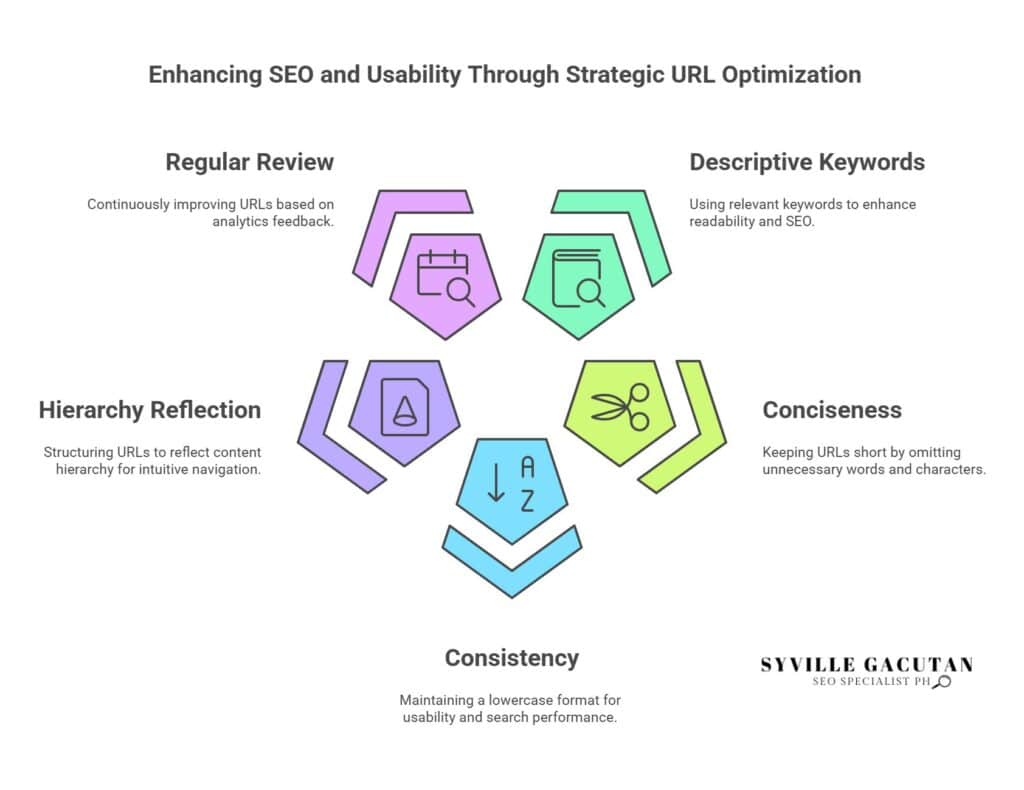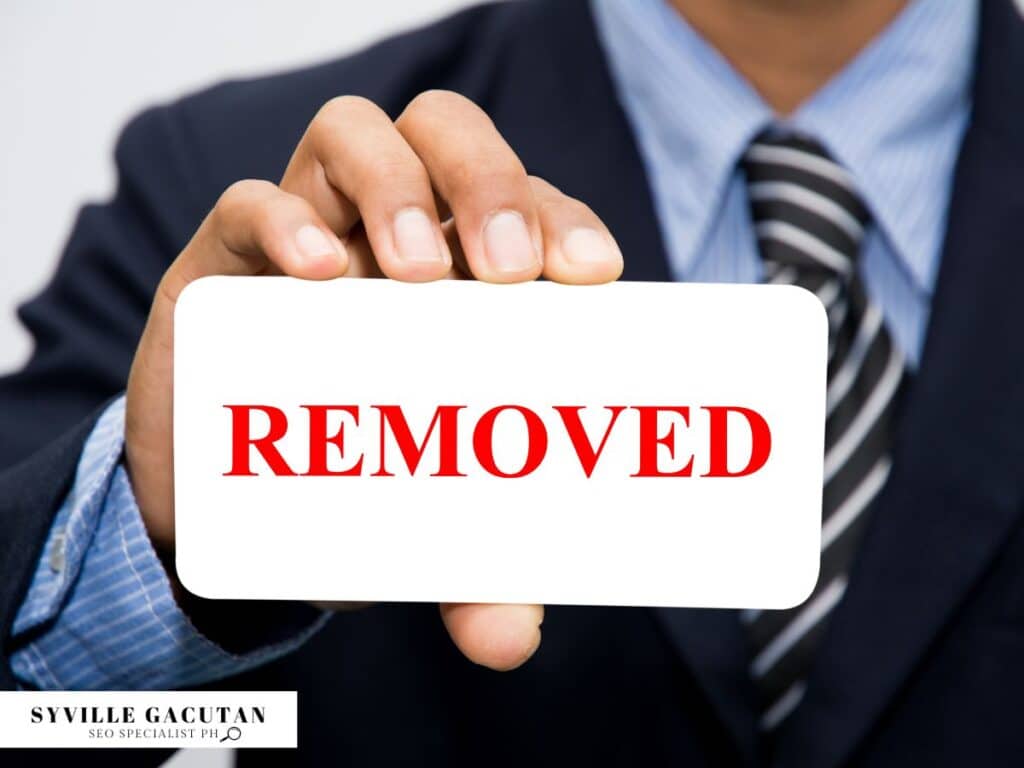
For an effective and clean URL structure, start by incorporating descriptive keywords that reflect page content, as this boosts SEO and user experience. Make URLs short by skipping extra words & symbols. Replace spaces with hyphens for better readability and search engine optimization. Use lowercase letters throughout the text, avoid excessive commas and keep writing style steady & uniform. This ensures predictability makes it easy to read and navigate Utilize canonical tags to manage duplicate content and guide search engine bots accurately. These practices not only enhance visibility but also encourage user engagement, paving the way for a more successful web presence. For further insights, explore additional strategies.
Key Takeaways
- Use descriptive keywords and hyphens for readability and SEO enhancement.
- Keep URLs concise by omitting unnecessary words and special characters.
- Maintain a consistent lowercase format to optimize usability and search performance.
- Reflect content hierarchy in URLs for intuitive navigation.
- Regularly review and adjust URLs based on analytics for continuous improvement.

Use Descriptive Keywords

Incorporating descriptive keywords into your URL structure is a critical practice for enhancing both user experience and search engine optimization. A clean URL that effectively employs descriptive keywords provides clarity, allowing users to anticipate the content’s subject matter before clicking. This practice not only communicates relevance but also contributes to building trust with your audience, as they are more likely to engage with content that is straightforward and transparent.
From an SEO perspective, using descriptive keywords in your URLs can significantly enhance visibility on search engines. When search algorithms parse URLs, they give weight to keywords found within them. Thus, integrating SEO-friendly URLs by including targeted keywords can improve your site’s ranking potential. It is essential to strategically select keywords that mirror the search intent of your target audience, thus ensuring that your content appears in relevant search results.
Clean URLs devoid of unnecessary parameters or clutter further optimize search engine indexing and user accessibility. By eliminating superfluous elements and focusing on the primary keywords, you create a streamlined path for both search engines and users. This optimization not only aids in indexing but also enhances the likelihood of click-throughs, as users can easily comprehend the page’s focus.
Ultimately, the thoughtful integration of descriptive keywords into your URL structure aligns with best practices for creating SEO-friendly URLs. This alignment not only bolsters search engine performance but also enriches the user’s journey through clear, concise, and optimized pathways, thus driving higher engagement and satisfaction.
Keep URLs Short
A concise URL acts as a succinct roadmap for both users and search engines, effectively guiding them to the desired content without unnecessary detours. To keep URLs short not only enhances readability but also contributes to a more professional appearance, which can significantly improve the user experience.
In an era where digital attention spans are diminishing, providing simple URLs is crucial. An optimized URL is not just about aesthetics; it is an essential component of a well-rounded SEO strategy that promotes clarity and efficiency.
Short URLs are easier to read and share, both essential factors in the digital landscape. When URLs are concise, users are more likely to remember and share them, thus extending your content’s reach. Moreover, search engines prefer URLs that convey the page’s content clearly and succinctly, which can improve your site’s ranking.
To achieve this streamlined approach, consider implementing the following practices:
- Prioritize essential words: Focus on including only the most critical words that convey the page’s purpose or content.
- Omit unnecessary words: Exclude filler words such as “and,” “the,” or “of” unless they are critical to the URL’s meaning.
- Use hyphens to separate words: This improves readability, making the URL more user-friendly and easier to interpret by search engines.
- Limit folder depth: Aim to reduce the number of folders or directories in the URL path to maintain simplicity.
- Avoid using parameters: When possible, replace complex parameters with descriptive words to keep the URL straightforward.
Adhering to these practices will help ensure that your URLs remain concise, optimized, and effective in guiding both users and search engines alike.
Avoid Special Characters

Why do special characters in URLs pose a challenge? Special characters, such as &, %, and $, can complicate a URL’s readability and functionality. For a clean URL structure, it’s crucial to ensure that URLs remain intuitive and straightforward.
When special characters are present, they often require encoding, making the URLs longer and harder to decipher. This complexity not only affects user experience but also poses challenges for search engines trying to crawl and index your site efficiently.
A clean URL structure should be easy to read and understand both for users and search engines. Special characters can disrupt this clarity, leading to potential misinterpretations. For instance, certain characters have specific functions in URLs, like the question mark (?) which begins query strings, potentially leading to errors if misused.
Moreover, URLs cluttered with special characters can deter users from clicking links due to perceived complexity or mistrust.
From an SEO perspective, an seo-friendly URL structure is paramount. Search engines prioritize URLs that are simple and include relevant keywords, as these are more likely to match search queries accurately.
Use Hyphens for Spaces

Utilizing hyphens in place of spaces within URLs is a best practice that enhances both readability and SEO performance. When crafting a clean URL structure, opting to use hyphens instead of spaces not only improves the visual appeal of the URL but also plays a crucial role in optimizing it for search engines.
Hyphens act as a separator for words, making the URL more legible for users and algorithms alike, which in turn can positively impact your site’s ranking on search engine results pages.
Incorporating hyphens into your URLs can significantly contribute to a more seo-friendly website. Here’s why:
- Readability: Hyphens create a clear distinction between words, making it easier for users to comprehend at a glance.
- Search Engine Optimization: Search engines interpret hyphens as spaces, aiding in the accurate parsing of keywords for indexing.
- Standard Practice: It is widely accepted as the preferred method among web developers and SEO experts alike, aligning with best practices for a clean URL structure.
- Avoiding Confusion: Unlike underscores, hyphens are not mistaken for hidden characters, reducing potential confusion for both users and search engines.
- Enhanced Keyword Recognition: Proper use of hyphens allows keywords in URLs to stand out, supporting better alignment with search queries.
Implement Lowercase Letters

When crafting URLs, one important consideration is the implementation of lowercase letters throughout. A clean URL structure not only enhances user experience but also optimizes search engine results. Lowercase letters help maintain a consistent and predictable URL format, which is crucial for both users and search engines navigating your website.
In the realm of search engine optimization (SEO), lowercase URLs are favored for their simplicity and uniformity. Search engines like Google differentiate between uppercase and lowercase letters in URLs, meaning that “ExamplePage” and “examplepage” could be interpreted as separate entities. This could lead to duplicate content issues, potentially diluting the ranking power of your pages. By standardizing your URL structure with lowercase letters, you mitigate this risk, ensuring that your content is indexed correctly and efficiently.
From a user experience perspective, lowercase URLs are easier to read and type. They reduce the likelihood of errors when users manually enter a URL, as there is no need to remember whether certain parts should be capitalized. This small yet significant step towards a clean URL structure can greatly enhance user satisfaction, as it fosters trust and reliability in your website.
Moreover, the use of lowercase letters in URLs contributes to a professional and polished appearance. It reflects a level of attention to detail that users subconsciously appreciate.
Maintain Consistent Structure

A consistent URL structure is essential for maintaining the integrity and navigability of your website. By ensuring uniformity in your URLs, you facilitate a user-friendly experience while enhancing your site’s appearance on search engine results pages (SERPs). A consistent structure aids not only in user navigation but also ensures that search engines can easily crawl and index your content. This alignment between user and search engine needs is vital for improving your website’s visibility and, ultimately, its success.
One of the most effective ways to maintain consistency is by establishing a clear and logical URL structure from the outset. This involves crafting URLs that reflect the hierarchy and organization of your website’s content. Consistent use of keywords in your URLs not only enhances clarity for users but also contributes to better search engine optimization (SEO).
Here are some best practices for maintaining a consistent structure:
- Standardize Your Format: Use a uniform format across all URLs to ensure predictability and ease of navigation.
- Logical Hierarchy: Reflect the site’s content hierarchy within the URL, making it intuitive for users and search engines alike.
- Keyword Integration: Incorporate relevant keywords naturally within the URL to boost SEO without compromising readability.
- Avoid Redundancies: Keep URLs concise by eliminating unnecessary elements that do not add value or clarity.
- Consistent Naming Conventions: Apply the same naming conventions throughout the site to avoid confusion and maintain uniformity.
Remove Unnecessary Words

Trimming excess words from your URLs is akin to decluttering a workspace; it enhances clarity and functionality. When creating a clean URL structure, one important guideline is to remove unnecessary words. This practice not only simplifies the URL but also improves user experience and search engine optimization.
An efficient URL should be concise and convey the essential information about the page’s content. By eliminating filler words, you streamline the URL, making it easier for users to read and remember.
Keeping your URLs concise is particularly beneficial for search engines like Google, which value straightforward and relevant URLs. When you remove unnecessary words, you help search engines better understand the page’s content and context. This can contribute positively to your site’s search ranking, as a clear URL structure is more likely to be favored by search engines.
For instance, a URL like “www.example.com/blog/clean-url-structure” is more effective and impactful than “www.example.com/blog/this-is-a-blog-about-how-to-have-a-clean-url-structure“.
Using a URL structure that incorporates only the essential keywords can also enhance user trust and click-through rates. When users see a URL that is neat, relevant, and easy to comprehend, they are more inclined to click on it.
Additionally, concise URLs are more adaptable for sharing across various platforms, which can lead to increased traffic. In summary, by focusing on removing unnecessary words, you enhance both the usability and the searchability of your website, thereby creating a more efficient digital presence.
Utilize Canonical Tags
Building on the practice of removing unnecessary words for a streamlined URL structure, another important aspect to consider is the implementation of canonical tags. Canonical tags serve a critical function in the realm of SEO, ensuring that search engine bots recognize the preferred version of a webpage when multiple URLs contain similar or identical content.
This practice not only helps in maintaining a clean URL structure but also enhances the effectiveness of your SEO strategy.
By utilizing canonical tags, webmasters can direct search engines to focus on specific URLs, thus maximizing the potential of targeted keyword research and minimizing the risk of duplicate content penalties. This approach is instrumental in creating SEO URLs that are both efficient and effective.
Below are key considerations when implementing canonical tags:
- Identify Duplicate Content: Conduct a thorough audit to pinpoint pages with similar content that might confuse search engines.
- Assign a Preferred URL: Use canonical tags to designate a single, authoritative URL for each set of similar pages, guiding search engine bots appropriately.
- Ensure Consistency: Maintain consistency across the website by applying canonical tags uniformly, reinforcing a cohesive clean URL structure.
- Monitor Performance: Regularly review web analytics to assess the impact of canonical tags on SEO performance and adjust as necessary.
- Integrate with Keyword Strategy: Align canonical tags with your keyword research efforts to ensure that the most relevant and optimized pages receive the intended search engine focus.
Incorporating canonical tags into your URL strategy is a sophisticated move towards optimizing your website for search engines while maintaining a seamless user experience.
This practice not only clarifies the hierarchy of your content but enhances the overall integrity of your site’s architecture.
Final Thoughts
Incorporating a clean URL structure is a fundamental step toward improving both user experience and SEO performance. By following best practices such as using descriptive keywords, keeping URLs concise, avoiding special characters, and maintaining consistency, you ensure that your website is both search-engine friendly and easy for users to navigate. Additionally, using hyphens, lowercase letters, and canonical tags further optimizes your URLs, enhancing visibility and engagement.
If you want expert assistance in optimizing your website’s URL structure and boosting your overall SEO performance, Syville Gacutan, a skilled SEO Specialist in the Philippines, is here to help. With proven expertise in crafting SEO strategies that drive results, Syville can guide you in creating a strong online presence. Contact Syville today and take the next step toward a more successful website.